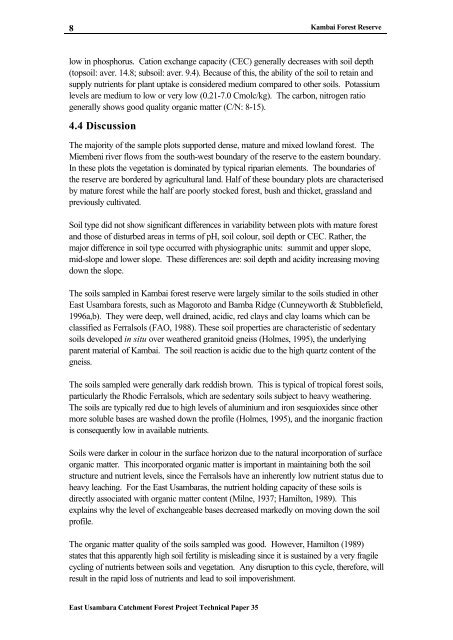Kambai Forest Reserve: A biodiversity survey. - Coastal Forests of ...
Kambai Forest Reserve: A biodiversity survey. - Coastal Forests of ...
Kambai Forest Reserve: A biodiversity survey. - Coastal Forests of ...
You also want an ePaper? Increase the reach of your titles
YUMPU automatically turns print PDFs into web optimized ePapers that Google loves.
8<br />
<strong>Kambai</strong> <strong>Forest</strong> <strong>Reserve</strong><br />
low in phosphorus. Cation exchange capacity (CEC) generally decreases with soil depth<br />
(topsoil: aver. 14.8; subsoil: aver. 9.4). Because <strong>of</strong> this, the ability <strong>of</strong> the soil to retain and<br />
supply nutrients for plant uptake is considered medium compared to other soils. Potassium<br />
levels are medium to low or very low (0.21-7.0 Cmolc/kg). The carbon, nitrogen ratio<br />
generally shows good quality organic matter (C/N: 8-15).<br />
4.4 Discussion<br />
The majority <strong>of</strong> the sample plots supported dense, mature and mixed lowland forest. The<br />
Miembeni river flows from the south-west boundary <strong>of</strong> the reserve to the eastern boundary.<br />
In these plots the vegetation is dominated by typical riparian elements. The boundaries <strong>of</strong><br />
the reserve are bordered by agricultural land. Half <strong>of</strong> these boundary plots are characterised<br />
by mature forest while the half are poorly stocked forest, bush and thicket, grassland and<br />
previously cultivated.<br />
Soil type did not show significant differences in variability between plots with mature forest<br />
and those <strong>of</strong> disturbed areas in terms <strong>of</strong> pH, soil colour, soil depth or CEC. Rather, the<br />
major difference in soil type occurred with physiographic units: summit and upper slope,<br />
mid-slope and lower slope. These differences are: soil depth and acidity increasing moving<br />
down the slope.<br />
The soils sampled in <strong>Kambai</strong> forest reserve were largely similar to the soils studied in other<br />
East Usambara forests, such as Magoroto and Bamba Ridge (Cunneyworth & Stubblefield,<br />
1996a,b). They were deep, well drained, acidic, red clays and clay loams which can be<br />
classified as Ferralsols (FAO, 1988). These soil properties are characteristic <strong>of</strong> sedentary<br />
soils developed in situ over weathered granitoid gneiss (Holmes, 1995), the underlying<br />
parent material <strong>of</strong> <strong>Kambai</strong>. The soil reaction is acidic due to the high quartz content <strong>of</strong> the<br />
gneiss.<br />
The soils sampled were generally dark reddish brown. This is typical <strong>of</strong> tropical forest soils,<br />
particularly the Rhodic Ferralsols, which are sedentary soils subject to heavy weathering.<br />
The soils are typically red due to high levels <strong>of</strong> aluminium and iron sesquioxides since other<br />
more soluble bases are washed down the pr<strong>of</strong>ile (Holmes, 1995), and the inorganic fraction<br />
is consequently low in available nutrients.<br />
Soils were darker in colour in the surface horizon due to the natural incorporation <strong>of</strong> surface<br />
organic matter. This incorporated organic matter is important in maintaining both the soil<br />
structure and nutrient levels, since the Ferralsols have an inherently low nutrient status due to<br />
heavy leaching. For the East Usambaras, the nutrient holding capacity <strong>of</strong> these soils is<br />
directly associated with organic matter content (Milne, 1937; Hamilton, 1989). This<br />
explains why the level <strong>of</strong> exchangeable bases decreased markedly on moving down the soil<br />
pr<strong>of</strong>ile.<br />
The organic matter quality <strong>of</strong> the soils sampled was good. However, Hamilton (1989)<br />
states that this apparently high soil fertility is misleading since it is sustained by a very fragile<br />
cycling <strong>of</strong> nutrients between soils and vegetation. Any disruption to this cycle, therefore, will<br />
result in the rapid loss <strong>of</strong> nutrients and lead to soil impoverishment.<br />
East Usambara Catchment <strong>Forest</strong> Project Technical Paper 35
















